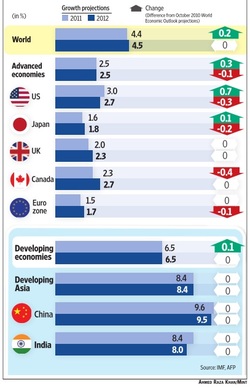The country registered a growth rate of 8 percent in 2009-10 compared to 6.8 percent last year. According to the latest Government estimates the high GDP rate is attributed to growth in transport, storage and communication along with financing, insurance and personal services. The Per Capita Income also registered an increase of 14.5 percent.
The index of six core industries also grew by 0.6 percent in April to December. The Index registered a provisional growth of 5.3 percent during April to December against 4.7 percent in the corresponding period in the previous year.
The six core industries include crude oil, petroleum refinery products, coal, electricity, cement and finished carbon steel. They together constitute over 26 percent of the total Index of Industrial Production.
Subprime lending, also called ‘B-Paper’, ‘near-prime’ or ‘second chance’ lending, refers to the practice of giving loans to borrowers at interest rates above the prevailing market rates because of their low credit status and increased risk due to either a limited credit history, or histories of payment delinquencies, charge-offs or bankruptcies. Subprime lending includes mortgages, credit cards and car loans. It is risky for both the lender and the borrower. It helps those consumers who otherwise would not have access to credit market. But on the flip side the borrowers do not have the resources to meet the long-term loan obligations. But the crisis began in 2006, when in the US, thousands of borrowers defaulted in payments; as a result many lenders had to file for bankruptcy leading to a direct impact on the US housing market and economy as a whole.
The Reserve Bank of India (RBI) on Tuesday hiked its indicative short term policy rates by 25 basis points to tame inflation and inflationary pressure.
The central bank raised the repo rate — the rate at which banks borrow money from the central bank — by 25 basis points from 6.25 per cent to 6.5 per cent and the reverse repo rate — the rate at which banks park their funds with the RBI — from 5.25 per cent to 5.5 per cent.
India's exports during November jumped by 26.8 per cent to $18.9 billion year-on-year. India's exports during April-September aggregated to $103.65 billion registering a year-on-year growth of 28 per cent.
India has emerged as one of the world's top ten countries in industrial production. The nation's industrial production grew at the fastest pace in three months at 10.8 per cent.Manufacturing grew 11.3 percent in October after a 4.6 percent gain in September.
Tourism is the largest service industry in India, with a contribution of 6.23 per cent to the national GDP. The number of foreign tourists visiting the country during September this year is higher than that of the same month last year.Around 3.69 lakh (369,000) foreign tourists came to India in September this year as compared to 3.28 lakh (328,000) during the same month in 2009.
India is among the top 10 nations in terms of foreign exchange reserves.The country's foreign exchange reserves breached the $300-billion mark for the first time since 2008 with an addition of $2.2 billion on the back of a healthy rise in foreign currency. The nation's forex reserves currently stand at $296.40 billion.
India ranks second in farm output globally. India is one of the largest producer in the world of milk, cashew nuts, coconuts, tea, ginger, turmeric and black pepper.
India owns over 18,000 tonnes of above ground gold stocks worth approximately $800 billion and representing at least 11 per cent of global stock, according to estimates of World Gold Council.India ranks 11th in the world with 557.7 tonnes of gold reserves.

 RSS Feed
RSS Feed